Gayle Irwin's Blog, page 6
June 2, 2020
6 Tips to Successfully Living with a New Cat
 Cats make wonderful companions and are generally low-maintenance compared with dogs.
Cats make wonderful companions and are generally low-maintenance compared with dogs.Pets touch our hearts and warm our homes – they provide companionship, comfort, and comedy. Whether hamster, guinea pig, iguana, parakeet, ferret, dog, or cat, an animal enriches our lives. June is Adopt-a-Shelter-Cat Month, an annual reminder of the joy of adopting and living with a cat.
Every year nearly more than three million cats enter animal shelters across America and more than 850,000 are euthanized because not enough people adopt them (and only about two percent of strays are reclaimed by their owners). Also, because of not spaying and neutering, the number of kittens born every year overwhelm the shelters and human societies as well as rescue organizations. Adopting a cat or kitten often saves two lives: the animal being adopted and the one waiting in line for shelter/rescue
However, bringing a new feline friend home shouldn’t be done on a whim. It’s wonderful to want to rescue and provide a loving home for a kitty, but a person should be prepared and deeply committed to providing a long-lasting, fur-ever home for a feline.
 Even though cats are more independent than dogs, kitties need care, too, including toys for their physical and mental health.
Even though cats are more independent than dogs, kitties need care, too, including toys for their physical and mental health.Here are six tips for successfully living with a new cat:
Recognize most cats are independent and be accepting of that. Cats are not like dogs, which are pack animals and relish the company of humans and (mostly) other dogs or pets. Cats are more loners that group animals, and therefore, aren’t often as social or lap-sitters.Do your homework and seriously think about the important decision of adopting. A pet should be for a lifetime, so make sure you’re ready to commit to that. Consider your lifestyle to help ensure the cat you’re looking to adopt best fits your home situation. Some breeds of cats are better with children than others, for example, and some types of cats are more social than others. For a list of cat breeds and their personalities and social, medical, and grooming needs, visit this website: https://www.hillspet.com/cat-care/breeds.Consider your finances and be sure you can afford a pet. Medical expenses can be costly, including spaying/neutering and vaccinations. Like people, pets can develop health issues due to genetics, accidents, or aging. For example, most cats are litterbox-trained at a young age, but later in life they can develop kidney failure and may not use the box as regularly. You might consider acquiring pet insurance, but that also costs money. Purchasing items such as cat food, cat litter, climbing and scratching posts, a pet bed, toys, and other items is like buying clothing, shoes, toys, food, and other things for a human child – necessary and frequent. Remember: nothing is free, not even a “free pet.”Think about the future. Are you planning to have a baby in the next few years or do you think you might be moving soon? The number one reason people give for relinquishing a cat to an animal shelter is “I’m moving” and a secondary reason is children, in particular having a new baby. Don’t let your furry friend be one of those statistics of abandonment because of a lifestyle change.Play with your cat. Even though cats may not need as much exercise and social time as dogs, engaging with your feline friend in games like catch-the-feather, chase the ball, or find-the-catnip mouse helps your new friend bond more to you. Do you know some cats can do agility and enjoy playing fetch? You and your kitty can spend a lot of time engaged in play, which is good for your cat’s mental and physical health.Keep your cat’s coat healthy. Grooming is good for both long-haired and short-haired cats. Start brushing your cat’s fur at a young age (if your new friend is a kitten) or as soon as you adopt your adult cat. Grooming your cat regularly helps keep mats at bay, and if those do get out of hand, or if your long-haired kitty becomes too hot in summer, seek the help of a professional cat groomer to remove stubborn mats and/or shave your cat for the summer.
For more cat care tips, visit the website of the ASPCA (American Society for the Prevention of Cruelty to Animals): https://www.aspca.org/pet-care/cat-care/general-cat-care.
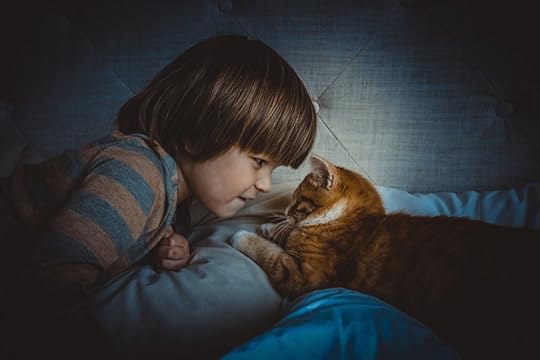 Taking care of a cat can be shared by the entire family.
Taking care of a cat can be shared by the entire family.Having a pet makes a home more cozy, warm, and loving. Pets are devoted to their humans – they love us unconditionally – and like children, they depend on us for care. Although cats may naturally be independent, that doesn’t mean they aren’t attached to their human friends or that they don’t enjoy the company of their special people. Cats can be comical as well as comforting and special, devoted companions. Therefore, make sure you’re ready and that you’re willing to be faithful to your new feline friend. Cats can live 10 to 20 years, some even more, so please be committed to your kitty for its lifetime.
May 26, 2020
Keep Your Pets Safe This Summer: 10 Tips to Enjoy a Fun Season with Your Furry Friend!

Now that Memorial Day in the United States has passed, the new season of summer approaches. These warming days bring unique safety concerns for our pets, from pests like ticks to sunburn and high water. Here are ten tips for enjoying a safe summer with your furry friends:
Ensure your pets’ vaccinations are up-to-date and that you have administered heartworm, flea and tick medications. Summer brings out rabies-carrying creatures, such as skunks and raccoons, and fleas and ticks are abundant this time of year. Consult your veterinarian for more information on prevention from heartworm, Lyme disease, rabies, and other life-threatening diseases.When planning your dog’s daily walk, seriously consider early morning or later in the evening when it’s cooler. Sidewalks aren’t so hot, therefore, the possibility of burned paws is lessened, and not going out during the heat of the day helps alleviate chances of sunburned pet noses and ears.Provide a life vest if you take your dog boating or swimming. Contrary to what many people think, not all dogs swim or swim well. Dogs can and do drown. Even the best of swimmers, like Labrador retrievers, can lose their life in the water, especially a swollen, fast-moving river or stream so ensure your pet’s safety in and near the water.If your dog spends time outdoors in a kennel, ensure he has plenty of fresh, cool water and shelter with shade. Rain and thunderstorms can pop up quickly, particularly in the afternoon when you may be elsewhere, such as at work. NEVER chain or tie your dog out – lightening striking a nearby tree, heat exhaustion, dehydration and numerous insect bites are just a few of hazards posed to tethered dogs.Don’t leave pets unattended in your vehicle. Cars quickly heat up to dangerous temperatures, especially on warm or sunny days, even with the windows slightly open. Every year hundreds of pets die from being left in vehicles.For your cat’s protection, keep her indoors. Cats can be purr-fectly content indoor pets – they just need is a bit of playtime, a cat tree and other enrichment. Keeping your kitty indoors protects her from rabies from roaming creatures, death by car or dogs, and other safety issues, such as car coolant leaks.Pesticides, weedkiller and other chemicals pose dangerous risks to pets and may even result in death. Ensure your pet cannot get into any of these hazardous products, and highly consider using organic products on your garden and yard.Prior to traveling with your dog or cat, look into accommodations that accept pets. BringFido.com can help you plan your pet-friendly vacation, providing lodging listings as well as restaurants, activities, and events where pets are welcome: www.bringfido.com.If your pet travels with you, make sure his/her ID tags are on the collar of your pet before traveling – microchips are helpful, too. Also, make sure all information, such as your phone number, is up-to-date. Use a leash to walk your pet for its bathroom break at a rest stop. One of the worst ways to ruin your vacation is to lose your pet.If you don’t take your pet on vacation with you, hire a reliable pet sitter. Ask friends or your vet for recommendations or check out a website such as http://www.rover.com. NEVER leave your pets home alone if you’re gone for an extended time. Even asking friends to “drop by” to feed and water isn’t enough. Things can happen if a pet is left alone for days: running out of water, yard and house destruction, incessant barking, which can upset neighbors – and possibly a fine to you by animal control.
Follow these guidelines and enjoy a safe and happy summer with your pet!

May 19, 2020
Is Your Dog a Digger? 3 Preventative Tips
 Dachsunds are natural diggers, bred to hunt vermin and go underground to find rodents, badgers,a nd other animals farmers disliked.
Dachsunds are natural diggers, bred to hunt vermin and go underground to find rodents, badgers,a nd other animals farmers disliked.Do you dig your dog? Does your dog dig you….your yard?
Certain dog breeds, like terriers and dachshunds, were originally bred to dig in order to go after vermin on property, such as in farmer’s fields. Therefore, these types of dogs are born diggers and if you have a terrier or a dachshund, understand that such behavior is in their nature. Other types of dogs may dig due to boredom, in order to keep cool in summer, or they are seeking prey, such as mice or insects in the yard.
Alleviate Digging
 Your dog may dig for a number of reasons. If s/he isn’t spayed or neutered, your animal may try to escape to find a mate. Perhaps your dog is bored or the weather is too warm and s/he doesn’t have enough water. Try to determine the cause of your pet’s digging and then do something to change it.
Your dog may dig for a number of reasons. If s/he isn’t spayed or neutered, your animal may try to escape to find a mate. Perhaps your dog is bored or the weather is too warm and s/he doesn’t have enough water. Try to determine the cause of your pet’s digging and then do something to change it.If you don’t want your dog digging up every square inch of your yard, here are three ideas you can implement to alleviate the situation.
If your dog is seeking shelter from the sunshine and heat, it may dig a hole to cool off. Our blind dog, Sage, dug a large hole near the concrete patio at the first house we lived in and a smaller hole under the lilac bush; she would lay in one of those spots during the times outdoors in the summer heat. The solution, if you don’t want holes in your yard, is to bring your dog inside more often or to provide a comfortable, outdoor shelter and ensure your pup has access to plenty of water. If your dog still digs, try setting aside a special area where such behavior is okay.If you believe your dog digs because it’s bored, spend more time with your furry friend. Play fetch in the yard; go for an extra walk; have more cuddle-time on the couch (dogs, TVs, and couches go well together!). You can also provide interactive toys inside and outside the house or teach your dog new commands or tricks and spend about 10 minutes each day in training. You can also set up an agility course in the yard or join an agility club and spend time with your dog going through the activities. Border collies, Australian shepherds, corgis, and other breeds can become bored easily, and these are the types of dogs that relish activity and do well with agility. Any of the aforementioned ideas, or a combination of such activities, are great ways to provide extra entertainment for your pet as well as added time with you.Could your dog be digging to find something? If you think your dog is going after “prey,” such as ground squirrels, mice, or insects, the Humane Society of the United States suggests a pet parent “Search for signs of burrowing animals, then use safe, humane methods to fence them out, exclude them or make your yard or garden unattractive to them.” However, “Don’t use any product or method that could be toxic or dangerous to your pets or other animals. Anything that poisons wildlife can poison your dog, too.”
 Border collies and other breeds need constant and consistent activity; they become bored easily. Agility is a great activity for dogs like that, and border collies do well in agility.
Border collies and other breeds need constant and consistent activity; they become bored easily. Agility is a great activity for dogs like that, and border collies do well in agility.Understand Digging Behavior
Dogs also dig for other reasons, such as trying to escape the yard (perhaps your dog is afraid of something, like as a neighbor dog that barks and growls from across the fence, or someone has been teasing and harassing your dog from the alley), or your intact dog is trying to get out of the yard to search for a mate. Perhaps your dog is burying treats and food.
There are many reasons dogs dig. Try to understand the “why” of your dog’s digging behavior can help you address that behavior and work on changing it as needed.
Dogs aren’t the only pets that dig: many cats also enjoy digging in dirt, especially during hot days or to find mice and other creatures.
 Cats may also dig, especially to find mice or insects, or to find a cool outdoor space in the summer.
Cats may also dig, especially to find mice or insects, or to find a cool outdoor space in the summer.For more information on why dogs dig and how to take charge of the issue, visit these websites:
Why Do Dogs Dig?
May 11, 2020
Sweet Spring and Summer Reads – Romance Books That Feature Pets
 Reading a book is a relaxing activity, and one you can do with your pet beside you!
Reading a book is a relaxing activity, and one you can do with your pet beside you!For more than a year, I’ve researched Amazon for novels similar to my interests: contemporary romance stories that feature pets. As an avid pet rescue and adoption advocate, I embarked upon a new chapter in my writing life more than six years ago – to create a novel that educates as well as entertains, particularly informing readers about the challenges and joys of pet rescue and adoption. The result, Rescue Road, released last fall.
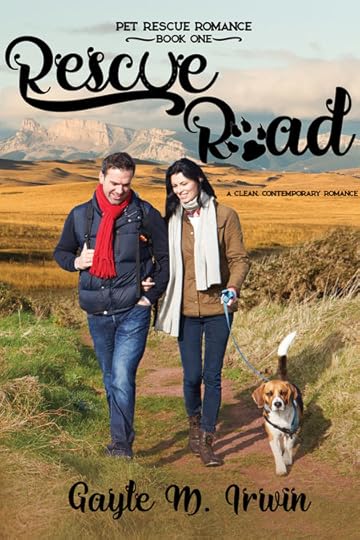
Discovering New Books
My Amazon research became more than just research about what’s already out there in such a genre and how much “shelf space” there might be in that line of romance books; it also became a way I discovered new books to read. I discovered Eliza Boyd who writes small-town romance with animals woven into the story, and Linda O. Johnston, who creates a tapestry of mystery within the pages of her romance stories that also highlight pet rescue and adoption. Both ladies have other books I plan to pick up for my winter 2020/2021 reading.
Recently, I found Debbie Burns who has created a series called “Rescue Me.” Her latest work, Head of Paws, relates the tale of a volunteer rescue transport driver (something I do when I can) who meets veterinarian Gabe Wentworth, who is volunteering for the same rescue. The two of them rescue a dog from drowning and the foundation is set for a delightful romance story. In this book, Debbie creates a few chapters from the dog’s perspective, especially the scene when the animal nearly drowns and another when it’s brought into the rescue and left there (Gabe already has a dog and with his vet practice, works too much to take on another, and Oliva lives with an aging aunt who doesn’t allow pets … except her own). The author’s descriptive writing engages readers; tears filled my eyes as I read the potential drowning scene from the dog’s perspective. I sensed its bewilderment and fear, and I felt its anxiety and longing to trust the two people (Gabe and Olivia) trying to save it. Burns has other books in the series, one of which I started to read the other day (My Forever Home). I look forward to absorbing her words as I did with Head Over Paws.

Add to Your Book Collection
Spring has arrived and summer looms on the horizon. These are great seasons to find new books for yourself and loved ones. Taking to the backyard, the patio, the campground, the beach – wherever your “special spot” may be and lounging with a good book. After the past few months we’ve experienced with all the COVID-19 craziness, something that hasn’t been confined is our opportunity to read. If you enjoy contemporary romance stories that feature animals, check out Burns, Boyd, and Johnston for starters.
In that same vein, I have a new book coming out later this month. Book 2 of my Pet Rescue Romance series, Finding Love at Compassion Ranch, releases May 20, 2020. The story takes place at a sanctuary for former research animals, which I’ve set in western Wyoming near Yellowstone National Park. The story is about Erin Christiansen, whom I introduced in Rescue Road. A widow, Erin has visited her sister in Montana and is returning home to Florida. She’s pledged two-weeks as a volunteer at Compassion Ranch. When she arrives, she discovers the ranch manager is a guy from her high school, Mike Jacobs, himself now a widower. Do the two have a second chance at love or are there too many obstacles to keep them apart?
This clean, contemporary western romance also highlights the fate of research animals, including horses, cows, sheep, dogs, and cats; the ranch’s mission is based on that of Kindness Ranch, located in eastern Wyoming. The book will be available in print and e-book formats.

I enjoy entertaining readers with my romance stories and I also like to educate them about a topic I’m passionate about: animal rescue and adoption. And I enjoy finding books of a similar nature. I hope you’ll find my new book, and my previous work Rescue Road, as well as the books by the other authors I’ve mentioned, enjoyable spring and summer reading.
Watch the book trailer for Finding Love at Compassion Ranch below.
May 5, 2020
Obesity: 4 Causes of Unhealthy Weight in Dogs and Cats and What to Do for Your Pet
 My cat Bailey has been carrying a pooch belly for a few years. She loves to sleep, but she will go into our backyard and explore during nice weather. Keeping her at a healthy weight is a challenge.
My cat Bailey has been carrying a pooch belly for a few years. She loves to sleep, but she will go into our backyard and explore during nice weather. Keeping her at a healthy weight is a challenge.Our 14-year-old cat Bailey has a pooch – and I don’t mean a dog friend. Weighing in at nearly 15 pounds, our aging feline is chubby; in other words, she is obese.
Like many humans, pets can pack on the pounds as they age. And that extra weight can cause health problems.
The Association for Pet Obesity Prevention reports nearly 60 percent of pets in the United States are overweight or obese, a statistic that hasn’t changed much in the past few years.
 Age, poor food, lack of exercise, and too many treats contribute to unhealthy weights in our pets.
Age, poor food, lack of exercise, and too many treats contribute to unhealthy weights in our pets.Contributing Factors to Pet Obesity
According to veterinarians and other pet experts, there are several causes of obesity in pets. Those include:
Bad labeling on pet food. People may follow feeding directions on pet food labels, which is not always the best advice, according to Dr. Nancy Kay, DVM. She recommends pet parents talk with their veterinarian about how much to feed their furry friend(s), and also calculate the number of calories for the animal’s size as well as evaluate your animal’s breed, size, and activity level.Feeding too many treats – and the wrong type. Small dogs don’t need to eat as many treats as larger breeds; in fact, for small pets, feed only a portion of a treat, or give them tiny amounts. Many types of treats are filled with wheat and corn, considered filler and of no nutritional value. Research treats and food before giving your pet whatever is available (and cheap) at the store. You may even want to create your own.Lack of exercise. Many pets, especially cats, are not exercised regularly. Cats are known to sleep many hours a day, but that can be nipped in the bud, along with being overweight, simply by engaging your kitty in games. The same is true with dogs. Some ball-tossing and fetching in the backyard and walks around the neighborhood will help keep your furry friend lean and trim – and healthy. With spring upon us, our dogs can spend more time outdoors, helping to keep us healthier, too!Breeds pre-disposed for obesity. Some pet breeds seem more prone to becoming overweight than others. For example, among cats, the Persian and domestic shorthairs often become chubby on a greater level than other felines, and in dogs, Labrador retrievers, basset hounds, and pugs are susceptible to being overweight.
 Exercising our pets helps keep them healthy, mentally and physically.
Exercising our pets helps keep them healthy, mentally and physically.Being cognizant of your pet’s weight will ultimately help manage health problems, such as diabetes, cardiac disease, and arthritis. Sometimes pet parents have to put their furry family members on a diet. Adding extra exercise can help keep weight in check as can cutting down on the number of and types of treats. Perhaps a mixture of all three will help your pet if it’s overweight.
Talk with your veterinarian about how to slim down your overweight pet – or about how to keep him/her leaner and healthier before s/he becomes obese.
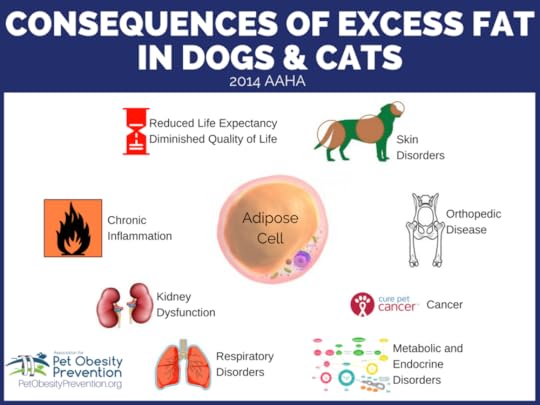
If you’re interested in making your own dog treats, a friend recently shared this recipe with me:
Three Ingredient Dog Treats
1 cup old fashioned oats, blended
1/3 cup 100% pumpkin puree
1/4 cup peanut butter
Add pumpkin and peanut butter to ground oats. Blend together well. Roll out thin on a mat coated with some ground oats to prevent sticking. Cut small squares with a pizza cutter, shot glass, or very small cookie cutters. Bake at 300 degrees for 25-30 minutes until dry. Keeps well if kept dry.
April 28, 2020
Choosing Your Pet’s Food is Not Necessarily Easy
 Carrots can be a healthy treat for dogs, and can even become a backyard toy!
Carrots can be a healthy treat for dogs, and can even become a backyard toy!When feeding time comes around, does what your pet ingests really matter? The answer is a resounding YES!
Pet food recalls happen frequently. Salmonella, Listeria, Vitamin D, even poisons and medications like phenobarbital have made it into commercial dog and cat food. Whether the pet food is dry, canned, or raw, recalls take place frequently, and it seems to not matter if the brand is considered quality, recommended by veterinarians (like Hill’s Science Diet or Royal Canid), or poorly made – pet foods are susceptible to manufacturing problems and recalls.
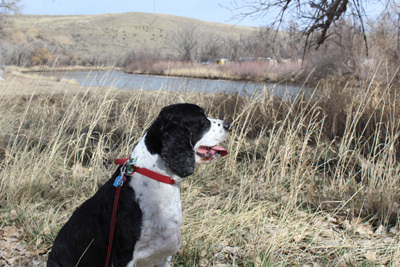 Mary enjoyed strolls near the river in our community. Her spaniel instinct to find birds, squirrels, and other animals always kicked in during our outings. She died of cancer in 2019 at the age of 13.
Mary enjoyed strolls near the river in our community. Her spaniel instinct to find birds, squirrels, and other animals always kicked in during our outings. She died of cancer in 2019 at the age of 13.Over the years, I’ve lost three dogs to cancer. Mary, a springer spaniel my husband and I had for more than six year, died from the disease last April. We began feeding her FreshPet, a semi-cooked pet food that is refrigerated, a few months before she passed. FreshPet has never experienced a recall, and upon reading the ingredients found in the grain-free turkey roll, I discovered many of those ingredients (such as blueberries and spinach) are recommended in a cancer diet for pets. I’m more conscious about the food I feed my pets than I was five or ten years ago.
Like any pet food product, one can find positive reviews and negative ones. Choosing a pet food is not necessarily easy.
Some people believe in feeding “raw.” Because many pet owners are suspicious of what goes into pet food, and what is left out, they have began feeding their dogs and cats more foods that people also eat, including meats and vegetables. Benefits of such a diet include healthy skin and coat, cleaner teeth, and keeping the animal at a healthy weight. However, this type of feeding program can also be expensive … but, then again, so can the price of kibble and canned pet foods.
 What to feed our pets isn’t a decision to be taken lightly. Talk with your pet-loving friends and your vet, and do research — not all pet food is created equal.
What to feed our pets isn’t a decision to be taken lightly. Talk with your pet-loving friends and your vet, and do research — not all pet food is created equal.We pet owners need to conduct research and not buy a food product because “that’s what we’ve always fed our animals.” Talk with other pet owners. Talk with your veterinarian. Do online research. Sites such as DogFoodAdvisor.com, Petful.com, and ConsumerSearch.com can help you find good food for your pets. Many sites also list pet food recalls, including the American Veterinary Medical Association (AVMA) and the Federal Food & Drug Administration (FDA).
Even if you feed your pet “human food,” such as chicken, beef, and turkey, spinach, blueberries, and kale, you should keep an eye open and an ear to the ground regarding recalls and alerts (remember the Romaine Lettuce problem?) These foods can also become contaminated with E. coli, Salmonella, and other bad things. I thoroughly wash vegetables and fruits and cook meats before feeding such things to my dogs just as I do before eating these products myself.
Whether you feed your pet kibble, canned pet food, raw, or partially cooked human food, do your homework – research, investigate, discuss, and then choose what you think is best for your furry friend. Even if you pay more to feed your pet, a trip to the veterinarian and the potential (or actual) loss of your companion are much higher costs than providing the best healthy diet possible.
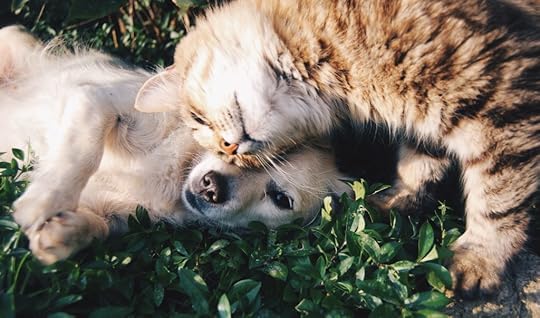 Our pets provide companionship, devotion, and love — shouldn’t we feed them the best we possibly can?
Our pets provide companionship, devotion, and love — shouldn’t we feed them the best we possibly can?For more information as well as guides on buying pet food and discovering which foods have recalls, visit the following sites:
https://yourdogadvisor.com/best-dog-food/
https://www.dogfoodadvisor.com/
https://pets.webmd.com/features/pet-food-ingredients#1
April 21, 2020
Keep Pets Safe from Toxic Household and Yard Products
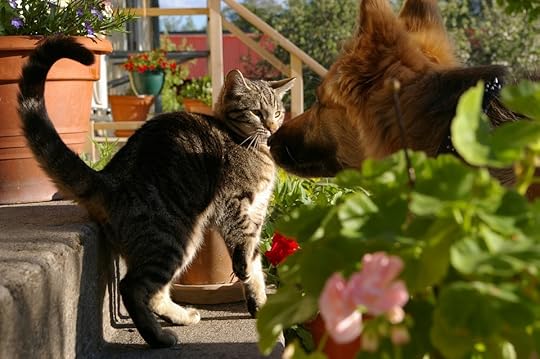 Whether outdoors or indoors, there are many items that humans use which can be harmful to pets.
Whether outdoors or indoors, there are many items that humans use which can be harmful to pets.As spring plants itself all around us and as many people are home more due to COVID-19, now is a good time to take inventory of the products in and around our house that can be toxic to our pets … and either dispose of them or keep them out of reach, not only out of children’s reach, but out of reach of our beloved dogs and cats.
Household Products
From cleaning supplies to medications, our home can be filled with items that can injure, even kill, our pets. Even human foods, such as onions, garlic, chocolate and grapes, can harm our animals.
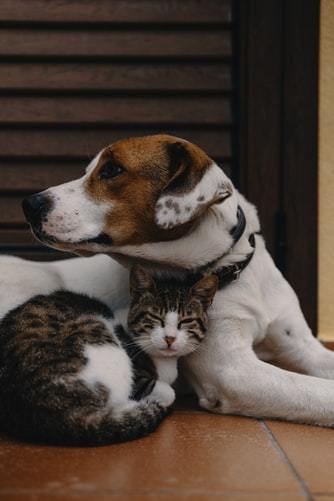
Cleaning products like window and bathroom cleaners and bleach, if ingested, can bring harm to our dogs and cats. Therefore, insure the cabinets or closets where such items are kept are high enough and secure enough to keep your pets from getting into such products. Additionally, when you use these items, keep your animals out of the rooms until everything dries. Better yet, switch to cleaners that are not toxic to dogs and cats – a listing of such items can be found here: https://www.rover.com/blog/16-pet-safe-non-toxic-cleaners-love/
Human medications are another source of toxic items in our homes. Ibuprofen and Naproxen, pseudoephedrine and other nasal decongestants, and some essential oils can harm or kill dogs and cats. Be aware how you store these items and make sure your pet cannot get into them.
Cosmetics and other beauty aids should never be left on the counter. Cats may grab a lipstick or lip balm to play with and accidently ingest some. Shampoo, body wash, and other products can also be detrimental to our pets’ health.
 Various types of flowers we enjoy growing and seeing can harm dogs and cats.
Various types of flowers we enjoy growing and seeing can harm dogs and cats.Outdoor Products
Did you some many plants we like to grow in our outdoor gardens can harm our pets? Flowers many of us enjoy, like lilies, daffodils, and daisies, can cause health issues in our pets. Additionally, plants, such as Sago palm and deadly nightshade, also harm pets.
Find a complete list of flowers and other plants that can harm, even kill, your pet(s) here: . https://www.aspca.org/pet-care/animal-poison-control/toxic-and-non-toxic-plants/d. You will also find a listing of plants that do not harm dogs and cats on that site.
Mosquito repellant not specifically made for pets is another potential toxin as are fertilizers, mulch, antifreeze, herbicides and insecticides. Rat and mouse poison can also be deadly to our cats and dogs. Just like with indoor cleaning products, there are safe alternatives for yard and garden use – find out more here: https://animalwellnessmagazine.com/pet-friendly-lawn-garden-chemicals/.
Bottom line: research, read labels, and keep items that can harm pets out of their reach.
The ASPCA (American Society for the Prevention of Cruelty to Animals) maintains an Animal Poison Control Center. If you suspect your pet has consumed something toxic, contact the hotline at (888) 426-4435.
Enjoy a safe and delightful spring!
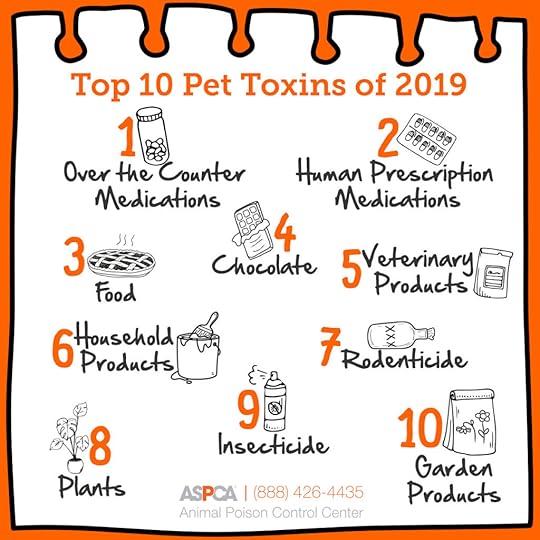 The Top 10 Toxins of 2019, from the ASPCA. Learn more at https://www.aspca.org/news/announcing-top-10-pet-toxins
The Top 10 Toxins of 2019, from the ASPCA. Learn more at https://www.aspca.org/news/announcing-top-10-pet-toxins
April 15, 2020
How to Keep Your Pet from Counter-Jumping and Surfing
 Sadie, our counter-surfing springer spaniel
Sadie, our counter-surfing springer spanielMy husband set the freshly-baked loaf of wheat bread on the counter. He turned back to the stove to stir the makings of our dinner. She took advantage of the moment and snatched the hunk of food, trotting toward the living room to feast. I captured our springer spaniel and ripped the bread from her mouth. Still, half the loaf remained between her teeth, and within seconds, disappeared.
Sadie had done the same with a chicken breast a month before and in between, we’ve had to whisk her out of the kitchen as my husband or I created sandwiches, eggs, hamburger, and other food items for ourselves. Yes, our dog is a counter-surfer … although we have been trying to break her of that bad habit.
 Many cats like to be up high, and tables and counters provide that height they seek. Provide better options for them, like cat trees and window sills.
Many cats like to be up high, and tables and counters provide that height they seek. Provide better options for them, like cat trees and window sills.Cats that jump on tables or counters. Dogs whose muzzles creep up to the dining table. Or, dogs, like ours, which lie in wait to snatch food from the counter or table. We’ve seen them, heard of them, maybe they are even our pets. How do we break our dogs and cats of these irritating (sometimes deadly) habits?
Coin Shaker
Dog trainer, author, and host of television’s “Lucky Dog” program, Brandon McMillan, uses a shaker bottle. Place pennies or other coins into a plastic water or soda bottle. Whenever your dog begins to counter surf (or your cat climbs onto the counter or table), shake the bottle; the noise should startle the animal and it may move away quickly. You can also use the command “OFF!” while shaking the bottle. You can also set up a baby camera in the kitchen so when you’re in a different room and you see on the ‘nanny cam’ that your pet being naughty, you can catch your dog or cat in the act and again, use the shaker and the word “OFF!”
Baby Gate
My husband and I use a baby gate to keep our surfer dog out of the kitchen. We sometimes forget to put it up (or get too lazy). We’re starting to learn our lesson, especially after the bread loaf theft!
Pet Kennel/Special Room
We’ve also employed using a dog kennel and having her be inside it while we eat. Not only does Sadie surf the counters, but she also sets her muzzle on the dining table. So, securing her in the kennel with a chew stick also works (her chew sticks don’t last very long, though, so the kennel keeps her confined so we can eat our meal slowly – unlike our inhaler of food!). Whether you use a separate room or a pet kennel/crate, keeping your pet away from your dinner allows you and your family to eat in peace.
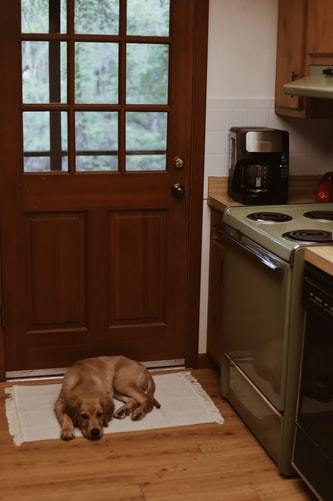 Employ obedience commands, safe areas like rugs, crates, or other rooms for your counter-surfing furry friends.
Employ obedience commands, safe areas like rugs, crates, or other rooms for your counter-surfing furry friends. Other Products You Can Use
Some people use items like aluminum foil or double-sided sticky tape on their counters. The foil employs a sound that animals don’t like as well as the slick surface. The texture of sticky tape is something else they don’t enjoy feeling. Scat mats are another product people use; these emit vibrations when a dog or cat touches the surface.
Keeping our dogs and cats off counters and tables is not only a matter of being less annoyed, but also can be lifesaving. Chicken bones, chocolate, garlic, and other human foods can be deadly for our pets. Therefore, employ ways to keep your animal off your tables and counters.

For more ideas and tips, visit these websites:
How to Stop a Dog From Counter Surfing
https://resources.bestfriends.org/article/dog-counter-surfing-prevention-and-deterrent
https://www.thesprucepets.com/stop-counter-surfing-551798
https://pets.webmd.com/cats/guide/keeping-cat-countertops-tables#1
April 6, 2020
Protect Your Pet Against Deadly Heartworm Disease
 My first dog was a German Shorthaired Pointer pup named Whitey. I was 12 years old living in Iowa.
My first dog was a German Shorthaired Pointer pup named Whitey. I was 12 years old living in Iowa.Whitey was the first dog I ever had. Let me tell you a quick story about him … and what you can learn from it.
When I was a child growing up in Iowa, my father raised and trained German Shorthaired Pointers. My dad thrilled to see these avid game bird dogs point and flush quail and pheasants, which roamed the woods and fields on our property and the neighbors’ lands. One year, his favorite female, Lil, gave birth to six puppies … all became sick immediately. Back in those days, dogs were kept outdoors, either tied/chained or in fenced-in runs/kennels. Veterinary care was an expense for most families, therefore, preventative care wasn’t a high agenda item in those days. Lil and her pups developed worms. All but one survived. Dad allowed me to keep a pup for myself, one that would not make a good hunting dog. Whitey and I had fun exploring the woods and fields around us. He loved chasing butterflies and shadows. However, his illness affected him all the short three years of his life.
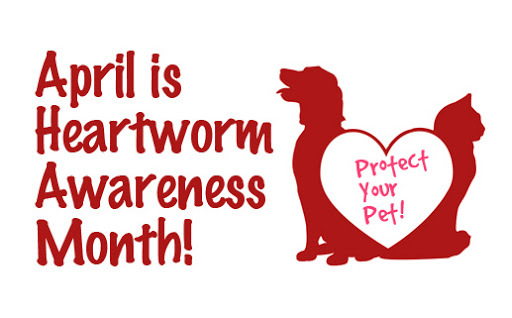
Heartworm Awareness
There are various types of worms that negatively impact our pets’ health, and oftentimes lead to an early death. April is Heartworm Awareness Month. This deadly disease creates undue suffering in dogs and cats. According to the American Heartworm Society, the disease, which used to be most prevalent in the southern United States, now impacts dogs and cats in every state. And, yes, cats can also contract heartworms.
Our pets get heartworm disease after being bitten by a mosquito carrying the microscopic larva in its saliva. That mosquito saliva gets into the dog or cat’s bloodstream, and the larvae travel to our beloved pet’s heart where they live and grow into adult worms. Pets may not show symptoms for months. For dogs, signs of heartworm disease include a mild persistent cough, hesitancy to exercise, fatigue after moderate activity, decreased appetite, and weight loss. As the disease progresses, your dog may develop heart failure and the appearance of a swollen belly due to excess fluid in the abdomen. Dogs that have large numbers of heartworms can develop a sudden blockage of blood flow within the heart, which leads to a life-threatening form of cardiovascular collapse called caval syndrome. This condition includes a sudden onset of labored breathing, pale gums, and dark bloody or coffee-colored urine. Without prompt surgery to remove the heartworm blockage, most dogs die.
Cat owners may not even realize their special feline has the disease until it’s too late. According to the American Heartworm Society, indications in cats “can be very subtle or very dramatic.” Symptoms include “coughing, asthma-like attacks, periodic vomiting, lack of appetite, or weight loss,” even difficulty walking, fainting or seizures, or, like dogs, fluid build-up in the abdomen. The Society goes on to say, “Unfortunately, the first sign in some cases is sudden collapse of the cat, or sudden death.”
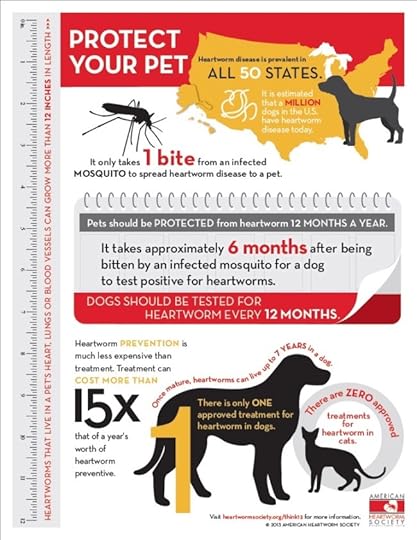
A Preventable Disease
So, how do we keep this from happening to our beloved pets? The great news is this killer can be easily prevented. Veterinarians prescribe medication to combat the disease before it even starts, generally in the form of a chewable tablet over the course of several months. Some vets may offer a topical medication. Your vet will also likely want to run a blood test first to ensure your pet isn’t already infected. This is an annual process, much like other disease prevention measures, such as distemper vaccines.
During the month of April, take time to consider your pets’ health, especially regarding heartworm disease. Keep your pets safe from this deadly menace by taking action to prevent heartworm disease. Contact your veterinarian and schedule an appointment soon – doing so may save your furry friend from suffering, even death.
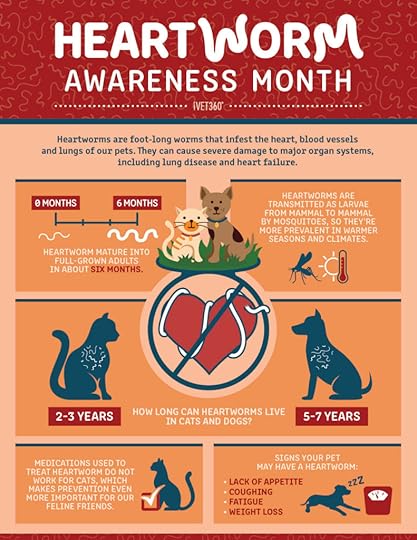
March 31, 2020
5 Stay-at-Home Activities You Can Enjoy With Your Pet

Does your state or community have a shelter-in-place order because of the coronavirus (COVID-19)? Do you have a pet staying home with you? There are several stay-at-home activities you and your pet can enjoy together during this unprecedented time. Here are five ideas:

Engage in interactive play. There are numerous interactive
toys for dogs
and cats.
These engaging items help your dog or cat tap into their
exploration or hunting instincts. There are puzzle toys, find-the-hidden-treat
toys, feather toys, and many other interactive games that you and your pet can
enjoy together … or that will keep your dog and/or cat busy while you spring-clean
your home or cook a special meal (maybe one that you can share with your pet!).Spend time outdoors. Whether you have a big
backyard or a small apartment patio, you and your pet can relish blue skies,
sunshine, and outdoor air. Lounge in a chair and read while your dog or cat
watches the goings-on or plays with toys. Clean out your garden planters or
flower beds while your dog runs through the yard. Teach your pet some new
tricks. No
matter the age or breed of your companion animal, dogs and cats can learn new
things. Cats can be taught to walk on a leash, helping kitty safely enjoy the
outdoors. Dogs can learn to speak, to roll over, to give high-five. Cats can
learn to come when called. While you’re staying home, keeping yourself and your
family as safe as possible during the COVID-19 pandemic, take the time to teach
your pet obedience
commands and fun
tricks. Engaging in these activities is fun for your pet and helps solidify
the bond between you and your dog or cat. Set up an indoor (or in-the-backyard)
agility course. One
of the most fun, interactive, and engaging activities you and your pet can do
is agility (and yes, cats
can learn agility too!). Whether you set up the course in your backyard or
your home/apartment, you and your four-footed friend can enjoy exercise and fun
with agility. Tunnels, weave poles, and jumps can be purchased
online and are fairly easy to set up. Watch movies and
documentaries on the couch. Don’t forget to relax! Whether you have Netflix, Amazon
Prime, Hulu, or some other streaming service or you prefer DVDs or cable TV,
there are multiple ways to enjoy relaxing on the couch with your furry friend. Nature documentaries about
national parks and oceans, for example, can be relaxing as well as
informational. There’s even programming
especially designed for pets, including DVDs for
cats. After some time exercising and being active, CHILL and enjoy
some relaxing programming.

Staying
at home during this COVID-19 era can still be fun as well as relaxing,
especially when shared with a pet. Spend additional time with your pet; let your
companion animal help you relieve stress and anxiety simply by being with you.
Adding activity to the mix can also be enjoyable for both you and your dog or
cat. Relish the spring days and the time you have with your furry friend and
strengthen the bond you share.




